



| Species Name | White-tailed sea Eagle |
| Japanese Name | Ojirowashi |
| Scientific Name | Haliaeetus alibicilla |
| Length | Male 75 - 90cm, female 85 - 98cm |
| Wingspan | Male 199 - 225cm, female 202 - 228cm |
| Weight | About 3 - 7kg |
| Distribution | Eurasia, Eastern Russia, Hokkaido, etc. |
A large sized eagle, the namesake white tail feathers give it it's name. Although considered a migratory bird, there are some resident individuals that breed in Shiretoko. It is estimated about 20 pairs use the Peninsula for breeding. Shiretoko has natural coastlines and forests, making it an ideal nesting site for the white-tailed sea eagles. In March, large nests are built in the largest trees along the cliffs. The eggs hatch between late April to early May, and the parents will deliver the food to the chicks. Mainly feeding on fish and seabirds, occasionally an unlucky short-tailed shearwater (who also comes for breeding during the same period) will become a meal.
In July, the chicks start flying practice while still in the nest, and will fledge from mid-July to early August. Even after fledging, family groups can still be observed near the nest sites, as the young birds will take time to become independent, long after leaving the nest. For the young birds, it will take an additional 6 years or more to become a breeding adult. On the other hand, the number of white-tailed sea eagles that arrive from their winter breeding grounds in Sakhalin, Kamchatka, and the South Kuril Islands, seem to be increasing every year, making them appear to have some flexibility in their preferences.


| Species Name | Steller's Sea Eagle |
| Japanese Name | Owashi |
| Scientific Name | Haliaeetsu pelagicus |
| Length | Male about 88cm, female about 102cm |
| Wingspan | 220 - 250cm |
| Weight | About 6 - 9kg |
| Distribution | Breeding on the coast of the Sea of Okhotsk |
The largest eagle that can be observed in Japan. Larger than the white-tailed sea eagle, The Steller's sea eagle has a wedge-shaped tail when it flies. Breeding in the coastal areas of the Kamchatka Peninsula and the Sea of Okhotsk as well as on surrounding islands. In the winter, these areas become covered in ice, so many of Sea eagles come to Hokkaido for to over-winter.
From February to March, the coast on the Shari side is covered with drift ice that consolidates, covering the surface of the sea and coastline, making it very difficult for the birds to feed. However, the opposite Rausu side will not have drift ice, and the drift ice zone is usually floating on the strait, so Steller's sea eagles mainly wintering along the coast on this side. The appearance of Steller's sea eagles flying on the drift ice looking for bycatch from fishing boats in Rausu, attracts avid bird watchers and photographers from abroad.


| Species Name | Subspecies of owl / Hokkaido ural owl |
| Japanese Name | Ezo fukuro |
| Scientific Name | Strix uralensis japonica |
| Length | About 50cm |
| Wingspan | About 98cm |
| Weight | About 600 - 800g |
| Distribution | Hokkaido, South Kuril Islands |
Slightly larger than a crow, has a large head but no ear tuffs and a face that makes it look like it is wearing a mask. Owls are generally distributed over a vast area from Scandinavia to East Asia. In Asia, they are distributed in northeastern China, North Korea, Sakhalin; and specifically, in Japan, can be found from Hokkaido to Kyushu. There are 4 or 5 subspecies in Japan (classifications still under debate), and the regional subspecies that inhabit Hokkaido is called the Hokkaido Ural owl (Ezo Fukurou). It basically has the same ecology as owls on mainland Japan, but is more whitish in color.
Hokkaido Ural owls are year-around residents and because they live in lowlands and forests near humans, they can easily be seen over most of eastern Hokkaido. Normally, nesting and egg-laying begins around March to April, with an incubation for about 30 days. Fledging takes only about 32 days after hatching. From April to June, is the best chance for pictures of the chicks perching inside a tree. Also in winter, the bare trees will make it easier to observe them.


| Species Name | Blakiston's fish owl |
| Japanese Name | Shima fukuro |
| Scientific Name | Ketupa blakistoni |
| Length | About 66 - 69cm |
| Wingspan | About 180cm |
| Weight | 3 - 4kg |
| Distribution | Hokkaido, Russia's far east, Southern Sakhalin, Kunashiri Island |
One of the largest owls in the world, it is about the same as a medium-sized dog sitting on the ground. The head has ear tuffs about 7 cm high which can look like dead leaves, as a camouflage.
The Ainu people highly valued the Blakiston's fish owl very much as "Kotankoro-kamui" or a village's guardian deity. It often appears in the oral literature "Kamuy Yukar" where it gives happiness to the family and saves them from famine. Many thought that the Blakiston's fish owl were living deep in the mountains, but they live in forests with large trees with gently flowing rivers and near fields. As the name Kotankoro-kamui suggests, it is a "village" bird that shares the same habitats as humans, just as the Ainu name reflects as it looks over the villages.
Currently, in the Blakiston's fish owl's habitat, the forests mixed with conifers and broad-leaved trees remain more than in other areas, and these forests contain gently flowing rivers where fish are easy to catch. As the Owl's name suggests, they mainly eat fish. There rivers have many small to medium-sized fish such as the whitespotted char 'Amemasu' and the Japanese masu salmon 'Yamame.' Unfortunately, the influence of dams has blocked the many migratory fish such as salmon and caused a decrease in the number of fishes the owls can catch. Meanwhile, the salmonid fish called Dolly Varden trouts 'Oshorokoma' are not affected by the dam because they tend to remain close to a certain section of the river. These fish ended up becoming a major factor in the survival of Shiretoko's Blakiston's fish owl population. However, due to loss of habitat the Dolly Varden trout has a limited habitat and is now an endangered species.
A Blakiston's fish owl invests a long time in breeding. In early Februrary, they mate and in a huge nest, large enough to accommodate a human, the female will usually lay one or two eggs. Only the female warms the eggs for about about 35 days. During which time the males mainly just carry food to females, rarely entering the nest. The chicks will fledge in about 45 days and as they improve their flying skills, will move farther away from the nest area, towards the end of July, still with their parents. After about a year, they will leave their parents' territory in search of their own territory. Young male birds tend to leave nest earlier and females tend to leave later. However, some young birds have been observed living in their parents' territories for more than two years. It is a unique characteristic of these owls to dedicate over a year to rear their young. Once the newly independent birds can find their own food, they will look for safe places to begin nesting to raise their own family. The areas with a place to roost, abundant in fish and has large trees for nesting are usually already inhabited by older Owls and they may repeatedly be kicked out of already established territories.
Blakiston's fish owls begin to search for mates at two years old, judging the other's gender by the sound of the hoot. With a very low voice, the owls call out to each other "Bo-bo." Once a pair is established, the male will double hoot "Bo-bo," and the female will reply with a single "Bo." It makes it sound as if it was only a single owl hooting.
 A pair of Blakiston's fish owls (September Photo)
A pair of Blakiston's fish owls (September Photo)
Blakiston's fish owl hunting occurs primarily between sunset and dawn, but during the breeding and winter seasons, can occasionally be seen during the day. Waiting on the riverbank looking for the signs of a fish, they will descend from the trees to hook the fish with their talons. If the water is shallow, they will even wait for hours sitting in the river. Most owls need to be able to fly silently as they ambush small animals, but the Blakiston's fish owls never evolved to do so, as the fish cannot hear their wingbeats. One owl family can eat more than 5,000 fish a year raising two chicks, so normally only one river can support one owl family. They will spend their whole life in one place once they pair up. In Shiretoko, there are only about 20 rivers suitable for raising chicks. These rivers already have their own established owl couples and owls have a long lifespan of about 30 years, so there is very little room for the next generations. Naturally, the number of rivers pre-determines the number of Blakiston's fish owls that can be supported.
 Blakiston's fish owl eating a Dolly Varden trout (June Photo)
Blakiston's fish owl eating a Dolly Varden trout (June Photo) The scientific name and common names for the Blakiston's Fish Owl, is named after Thomas Blakiston, a former British Army artillery captain. In 1883, he found various fauna in the Japanese archipelago differed across the Tsugaru Straits. He proposed that during the glacial and interglacial periods, that animals and plants found it difficult to make north or southward advances over a long period and the area was later called Blakiston's Line. Since it is located between Hokkaido and Aomori prefecture, it is also called the Tsugaru-Kaikyo Line.
The scientific name and common names for the Blakiston's Fish Owl, is named after Thomas Blakiston, a former British Army artillery captain. In 1883, he found various fauna in the Japanese archipelago differed across the Tsugaru Straits. He proposed that during the glacial and interglacial periods, that animals and plants found it difficult to make north or southward advances over a long period and the area was later called Blakiston's Line. Since it is located between Hokkaido and Aomori prefecture, it is also called the Tsugaru-Kaikyo Line.
Ultimately, the Tsugaru Strait which lies between Hokkaido and mainland Japan 'Honshu' limited the distribution of mammals and birds, so that creatures that only live in Hokkaido like brown bears, Ezo red foxes, Hokkaido sika deer, Hokkaido squirrels; have Honshu counterparts such as the Asian black bear, Japanese red fox, sika deer and Japanese macaque'snow monkey'.
Additionaly, adding the word "Ezo" to their names, such as Ezo Fukuro (Ural Owl) and Ezo Akagera (Ezo Great Spotted Woodpecker); as well as those names with the word "Shima" referring to Hokkaido, such as Shima-enaga (long-tailed tit) help distinguish the animals that have adapted to the cold weather of Hokkaido. They are separated from their Honshu counterparts as a subspecies in name because it distinguishes them as a northern morphological variation.


| Species Name | Japanese crane / Red crowned crane |
| Japanese Name | Tancho |
| Scientific Name | Grus japonensis |
| Length | Male about 137cm, female about 125cm When neck is extended when standing, it is about 150cm |
| Wingspan | 220 - 240cm |
| Weight | 6 - 11kg |
| Distribution | Northeastern Mongolia, Northeastern China, Ussuri-Amur regions, eastern Hokkaido |
The Japanese name of the crane is written as 丹頂 "Tancho": 丹 "Tan" means red, and 頂 "cho" means the top of the head. It received its name based on the Japanese crane's red colored-head.
This red part is not feathered but is exposed skin and when it is excited, the skin expands to show a bright red color.
The Ainu people call the Japanese crane "Sarurun kamuy" (God of the Marsh) and "Sarurun Chiri" (Bird in the Marsh). As the name suggests, the birds nest in the marsh's reed beds, keeping a fairly large territory of 1 to 7 square kilometers. In March they build nests and lay eggs, three times larger then chicken eggs, and the eggs are incubated for 32 to 35 days by both the male and female. The chicks can walk soon after hatching at 13 cm tall and weighing 130 g, and have a brown color to camouflage them among the dead grass. After only a few days after hatching, they leave the nest to live in the marshlands with their parents and do not return to the nest. For about a month after hatching, the small chicks sleep under the wings of the parent bird.
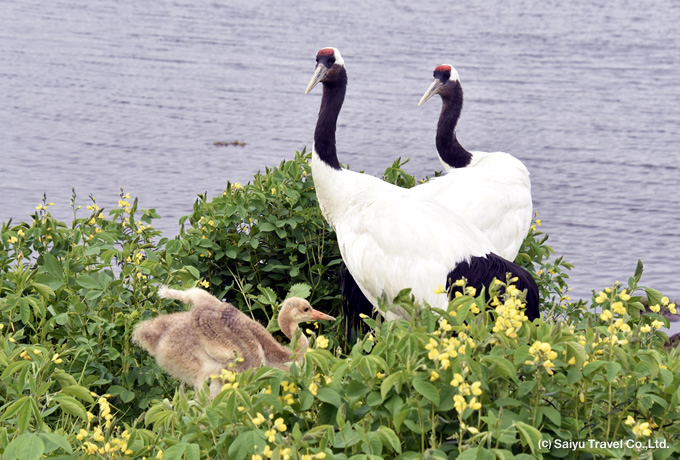 Japanese crane parents and chick (June Photo)
Japanese crane parents and chick (June Photo)After two months, the chick's down feathers will molt and the flight feathers will grow in as they grow, weighing about 5kg. Three months after much jump-flapping, they will be strong enough to fly and move to new areas of the marsh. By the fall, they will be about the same size as the adults, but still retain some brown feathers on their head, neck and body. The families will have started to frequent fields and villages by this time as well. Then, in the end of winter of the following year, they will leave their parents to look for a mate. Paired Japanese cranes confirm their bonds constantly with calls to each other. The Japanese crane's cry is very high pitched, carrying loudly over long distances of even 3km, which is where the Japanese proverb "the one call of the crane" comes from, meaning "the final word" or "the final word from the boss."
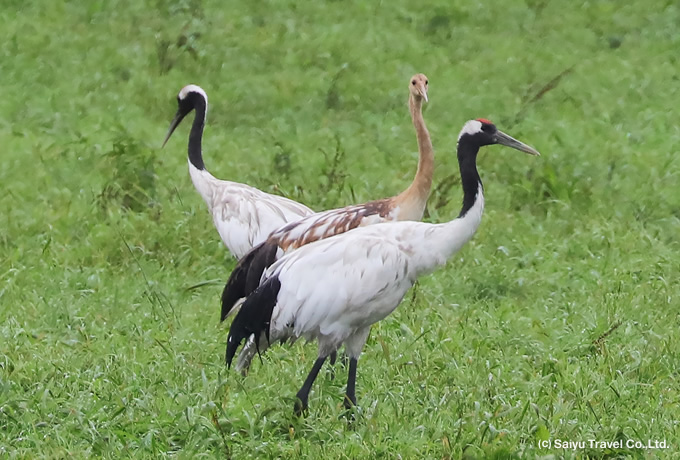 Parent and child of the Japanese crane (June Photo)
Parent and child of the Japanese crane (June Photo)As the dawn approaches, they begin to move around and will leave the roost to head to the feeding grounds in Tsurui Village and Akan city. As the sun rises, water vapor rises off the river and in very cold mornings, the air freezes and forms 'diamond dust' that makes for striking crane photos. From Otowa Bridge, you can see Japanese cranes sleeping in the Setsuri River. Typically cranes stay in small family units from spring to summer, but only in winter, as feeding areas are very limited, large flocks of Japanese cranes can be a beautiful sight.
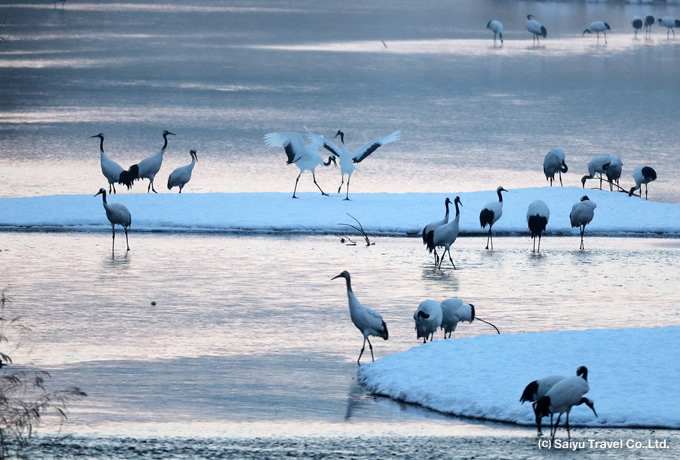 One morning in winter, a flock of Japanese cranes from Otowa Bridge (February Photo)
One morning in winter, a flock of Japanese cranes from Otowa Bridge (February Photo)As the sun sets, the Japanese cranes will move from the feeding areas to their nightly roosts. It is a good photo opportunity to catch the Japanese cranes flying against the setting sun. The roost is in a river, with high banks to block the wind and a place where the water flow is gentle yet deep enough to stand in. At first glance it may seem that being in the river must be bitterly cold, however even if the outside temperatures reach -20 ℃, the spring water doesn't freeze, and maintains a temperature of 10 ℃, which is much warmer than the outside temperature. In the safety of the river, they can rest assured that enemies, such as foxes, will not come after them. Preventing unnecessary movement helps keep them from body heat escaping during the cold night.
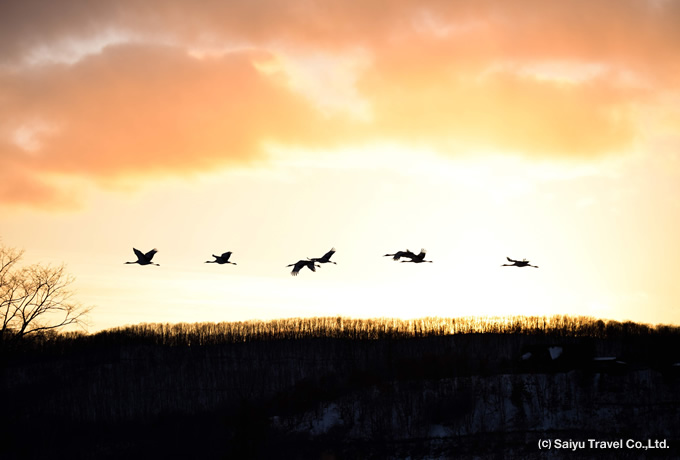 Japanese cranes flying in the dusk (February Photo)
Japanese cranes flying in the dusk (February Photo)

| Species Name | Shearwater |
| Japanese Name | Hashiboso Mizunagidori |
| Scientific Name | Pufinus tenuirostris |
| Length | 40 - 45cm |
| Wingspan | 95 - 100cm |
| Weight | About 500g |
| Distribution | Breeding on Australia's east coast & Tasmania |
As the English name of the Short-tailed Shearwater suggests, compared to other Shearwaters their tails are shorter and are about the size of a slender crow. After breeding in Australia's Tasmania, they move northward, and flocks start appearing in the waters near Japan from April until June. Then they travel to the Bering Sea and the Arctic Ocean. The distance between Tasmania and the Arctic Ocean round trip is about 32,000 km, almost the distance of circling the globe, making it the longest bird migration. Short-tailed Shearwaters travel this long distance in search of krill. During Australia's winter, krill is difficult to find in the nearby waters, but there are large amounts of krill in Shiretoko and the Arctic Ocean. During the time they are in the Nemuro Strait, their molting season begins, and despite it not being a good time for flying or feeding, they have an abundant food source.
The short-tailed shearwaters breeding season is from October to April. Only one egg is laid and there is only a 25% chance that this one chick will fledge and leave the nest safely. The parent birds feed the chicks with krill, but as the migration season nears, the parent birds must stop feeding the chicks to store their own fat to be able to survive the long journey. Therefore, if the krill population near Tasmania is too low, the chicks will face their first migration starting out undernourished. Only 8% are said to be able to survive this first migration to return to their breeding grounds as adults. In fact, the unfortunate stranding of the short-tailed shearwaters (drifting ashore) which failed to complete their migration, often happens along the coast of Japan.


| Species Name | Long-tailed tit |
| Japanese Name | Shima enaga |
| Scientific Name | Aegithalos Caudatus Japonicus |
| Length | About 14cm |
| Weight | About 8g |
| Distribution | Siberia, Japan, Korean Peninsula |
This small white and cute long-tailed tit is lovingly called the "Snow Fairy." From January to early March, in Japan, it can only be seen in Hokkaido. As a subspecies of the Japanese long-tailed tit, the Hokkaido version is smaller than a sparrow. Not counting the tail, it is the smallest bird in Japan. One will weigh about 8g and total length is about 14cm long, with the tail making up about half its length at 7-8 cm.
Unlike the mainland's long-tailed tit there is no pattern on the face, and the unforgettable white face with the black round eyes is so cute. Newborn chicks have a black face, but after a few months it will turn white, like their parents.


| Species Name | Spectacled Guillemot |
| Japanese Name | Keimafuri |
| Scientific Name | Cepphus carbo |
| Length | 39 - 41cm |
| Wingspan | 67 - 71cm |
| Weight | 500 - 600g |
| Distribution | Hokkaido Coast, islands of northern Honshu, Kamchatka, Kuril Islands, Sakhalin, East Coast of Korean Peninsula |
The Japanese name "Keimafuri" comes from the Ainu word "Kemahure" meaning 'red legs.' As the name suggests, it has bright red legs, and is a beautifully contrasting dark brown body with a white ring around its eyes. The winter plumage on the throat, chin, chest, and lower abdomen, becomes white, while the white ring around the eyes becomes smaller. It has a beautiful cry and is also called 'the canary of the sea.' Spectacled guillemots breed in a very limited range such as the coast of Kamchatka Peninsula, the Sea of Okhotsk, Teuri Island, Shiretoko Peninsula, Moyururi Island, and parts of Aomori Prefecture.
In Japan, Teuri Island is where spectacled guillemots are most easily observed, but in Shiretoko, they build nests in the holes and crevices of the cliffs around Utoro. From May to August, when the breeding season begins, sightseeing boats are the best way to see them. Many of Japan's seabird breeding areas are designated as protected areas, however the foraging areas are not protected. Therefore, when the birds are hunting for their food like the Japanese sand lance, it may dive into the sea but get caught in fishing nets. Currently, there is concern with the declining population of birds, and if the trend continues, there are fears that these breeding grounds may disappear as well.









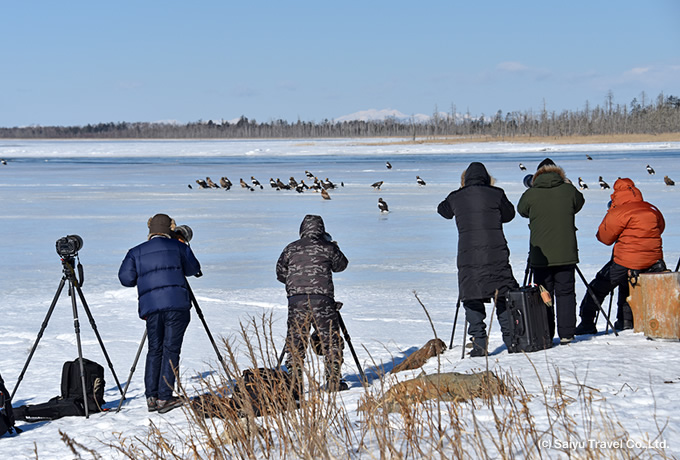 Photographers at the ready with their tripods at Lake Furen
Photographers at the ready with their tripods at Lake Furen
*These are wild animals, so there are no guarantees of their appearance as changes in weather conditions and the local environment will affect the wild animal's behavior.